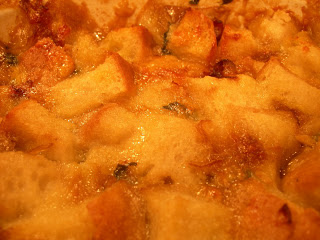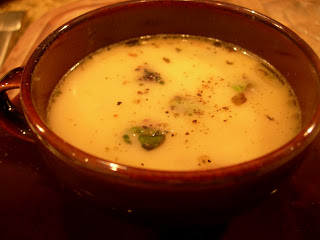Post
 Unctuous. Isn’t that a fabulous word? Chef Judy Rodgers uses it in her gorgeous The Zuni Cafe cookbook, specifically in her recipe for Chard & Onion Panade with Fontina, which I made today. And oh, unctuous it is… smooth, creamy, and rich. Almost deadly, in fact – it is so good, and so rich and substantial, I could imagine actually hurting myself with this thing, this panade. Good thing I’m a moderate epicurean (wink).
Unctuous. Isn’t that a fabulous word? Chef Judy Rodgers uses it in her gorgeous The Zuni Cafe cookbook, specifically in her recipe for Chard & Onion Panade with Fontina, which I made today. And oh, unctuous it is… smooth, creamy, and rich. Almost deadly, in fact – it is so good, and so rich and substantial, I could imagine actually hurting myself with this thing, this panade. Good thing I’m a moderate epicurean (wink).
So, a panade, what is it, other than unctuous and substantial? Imagine a cross between a silky, savory, crusty bread pudding and the best gratineed French onion soup you’ve ever had and you’ll be starting to get the picture. Alongside a roast, it would stand in as a moist, decadent stuffing. On its own, it would replace a risotto or pasta. Oh dear, I feel an obsession coming on…
And this isn’t all I made today! I also simmered a simple soup, thinking Nathan wouldn’t dig panade (I was quite wrong, it turns out). Chicken broth, little bacon, onions and garlic (in a bouquet garni, Nathan’s not a huge fan of lots of chopped onions in soup), herbs, and chicken, with a touch of cream to finish. And quickly sauteed bits of asparagus and a drizzle of truffle oil for John and me. With a generous grinding of black pepper, it was absolutely delicious.
Chicken broth, little bacon, onions and garlic (in a bouquet garni, Nathan’s not a huge fan of lots of chopped onions in soup), herbs, and chicken, with a touch of cream to finish. And quickly sauteed bits of asparagus and a drizzle of truffle oil for John and me. With a generous grinding of black pepper, it was absolutely delicious.
Way to put this snowy day to good use, eh? I’m sitting in front of a big, roaring fire as I type this, pleasantly full of soup and (mostly) panade, while John reads next to me… Nice. I’m thinking our soft bed (with clean sheets, yay!) is going to feel more-than-good when I slide in. Ahhhhh… (Recipes posted in comments, below.)





Chicken Soup with Bacon, Asparagus, & Truffle Oil
Stephanie Levy
Serves 6
Though the addition of bacon, cream, and Parmesan makes this soup look rich, they’re added in such small amounts that the end result is actually quite light.
2 strips bacon, diced
1 small onion, chopped fine
2 cloves garlic, minced
6 cups chicken broth
1 tsp. dried thyme
¼ c. long grain white rice
1 bunch small asparagus spears, bottom half of stalks discarded, top half cut into ½-inch pieces (about 1 cup of pieces, more if you like)
2 Tbsp. olive oil
1 cup cooked chicken, pulled into bite-sized pieces (rotisserie works nicely)
¼ c. freshly grated Parmesan cheese
¼ c. cream
salt and freshly ground black pepper to taste
optional garnish: truffle oil
In a Dutch oven over medium heat, sauté bacon until crisp. Stir in onion with a sprinkle of salt and lower heat. Cook onions gently, stirring occasionally, until soft, about 10 minutes. Stir in garlic, thyme, and rice and sauté for 2-3 minutes. Add chicken broth, bring to boil, then simmer uncovered over lowest heat for 20 minutes, until rice is tender.
Meanwhile, heat olive oil in a small skillet over medium heat. Add asparagus pieces and stir fry until tender crisp. Season lightly with salt and set aside.
When rice is cooked, stir chicken, Parmesan, and cream into the hot soup. Taste for salt. To serve, divide asparagus pieces into bowls, ladle soup over, and finish with a small drizzle of truffle oil and a generous grind of black pepper.
(To do ahead, you could prepare the soup without adding the cream or Parmesan, cool it, then chill. Before serving, heat the soup and sauté the asparagus, add the cream and Parmesan and serve as described.)
Chard & Onion Panade with Gruyere
From The Zuni Café Cookbook by Judy Rodgers
Serves 6 as a main course, 8-10 as a side
From the book:
A panade, literally, a “big bread thing,” is a fluffy, gratineed casserole of stale bread and stewed onions, moistened with broth or water (made with water, it might be tagged acquacotta, an Italian relation). Enriched with cheese and layered with greens or tomatoes, this primitive peasant gratin becomes an affordable luxury dish. We serve a generous scoop of panade by itself in lieu of soup, pasta, or risotto, or a smaller spoonful next to grilled or roasted birds or meat. In either case, scoop strategically when you serve, so everyone gets some of the craggy top. Whichever panade strategy you choose, don’t worry if it looks as if you will have too much. What isn’t consumed in second helpings has a future still: it is delicious panfried.
From Stephanie:
This thing is just absolutely amazing. It ends up soufflé-like, creamy and rich, with a fabulously crusty top. To die for. The recipe looks long, but it’s not at all difficult, nice for a winter’s Sunday afternoon preparation.
1 ½ lbs. thinly sliced sweet onions
½ cup mild-tasting olive oil (divided)
6 garlic cloves
salt
1 lb. green Swiss chard, thick ribs removed and cut into 1-inch ribbons and rinsed thoroughly in a colander
a little water, as needed
10 oz. day-old chewy peasant-style bread, cut into rough 1-inch cubes
Up to 4 c. chicken broth
6 oz. Fontina or Swiss Gruyere, coarsely grated (about 2 cups, very loosely packed)
Preparing the onions, chard, and bread:
Place the onions in a deep 4-quart saucepan and drizzle and toss with olive oil to coat, about ¼ cup. Set over medium-high heat and, shimmying the pan occasionally, cook until the bottom layer of onions is slightly golden on the edges, about 3 minutes. Stir and repeat. Once the second layer of onions has colored, reduce the heat to low and stir in the garlic and a few pinches of salt. Stew, stirring occasionally, until the onions are pale amber colored and tender but not mushy, another 20 minutes or so. If at any point the onions look as if they may dry out, cover them to trap some of the moisture in the pan. Taste for salt. You should get about 2 ¼ cups cooked onions.
Preheat the oven to 325 degrees (or as low as 250 degrees, if it suits your schedule to stretch the cooking time from about 1 hour 45 minutes to 2 hours 45 minutes; in general, the longer and slower the bake, the more unctuous and mellow the results).
Wilt the prepared chard: drizzle oil in a large skillet, set over medium heat. Add chard (with water still clinging to leaves) and a few pinches of salt. Stir and fold the leaves until they are just wilted, about 5 minutes. Taste. The chard may be slightly metallic tasting at this point, but make sure it’s salted to you taste. Set aside.
Toss the cubed bread with a few tablespoons of olive oil, a generous ¼ cup of the stock, and a few pinches of salt, to taste.
Building the panade:
Choose a flameproof 2-quart soufflé dish or enameled cast-iron Dutch oven. Assemble the panade in layers, starting with a generous smear of onions, followed by a loose mosaic of bread cubes, a second layer of onions, a wrinkled blanket of chard, and a handful of the cheese. Repeat, starting with bread, then onions, and so on, continuing until the dish is brimming. Aim for 2-3 layers of each component, then make sure the top layer displays a little of everything. Don’t try to make the layers flat or even; irregularity makes the final product more interesting and lovely. And don’t worry if you need to pack the layers a bit. Drizzle with any remaining olive oil.
Bring the remaining 3 ¾ cups chicken stock to a simmer and taste for salt. Add it slowly, in doses, around the edge of the dish. For a very juicy, soft panade, best served on its own, like a soup or risotto, add stock, nearly to the rim; for a firm but still succulent panade, nice as a side dish, fill to about 1 inch below the rim. Once you’ve added the stock, wait for a minute for it to be absorbed, then add more if necessary to return to the desired depth. The panade may rise a little as the bread swells.
Baking the panade:
Set the panade over low heat and bring to a simmer; look for bubbles around the edges. (Heating it here saves at 30 minutes of oven time; it also means every panade you bake starts at the same temperature, so you can better predict total cooking times.)
Cover the top of the panade with parchment paper, then very loosely wrap the top and sides with foil, dull side out. Place a separate sheet of foil directly under the panade or on the rack below it, to catch the inevitable drips. Bake until the panade is piping hot and bubbly. It will rise a little, lifting the foil with it. The top should be pale golden in the center and slightly darker on the edges. This usually takes about 1 ½ hours, but varies according to the shape and material of your baking dish, and your oven. (You can hold the baked panade for another hour or so; just reduce the temperature to 275 degrees until 20 minutes before serving.)
Browning and serving the panade:
Uncover the panade, raise the temperature to 375 degrees, leave until golden brown on top, 10-20 minutes. (If you aren’t quite ready when your panade is, re-tent the surface with parchment and foil and reduce the heat to 275 degrees. You can hold it another half hour this way without it overbrowning or drying out.) Slide a knife down the side of the dish and check the consistency of the panade. Beneath the crust, it should be very satiny and it should ooze liquid as you press against it with the blade of the knife. If it seems dry, add a few tablespoons of simmering chicken stock and bake for 10 minutes longer.
Present the panade full-blown, then allow it to settle for a minute before serving directly from the baking dish.